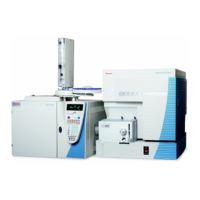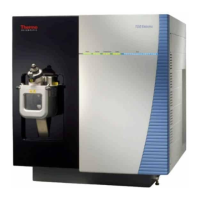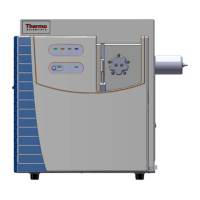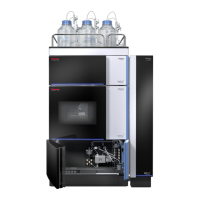2
Functional Description
Mass Spectrometer
Thermo Scientific TSQ Series Hardware Manual 31
Because the frequency of this ac voltage is in the radio frequency range, it is referred to as rf
voltage. In Figure 28, the solid line represents the combined rf and dc voltage applied to one
rod pair, and the dashed line represents the combined rf and dc voltage applied to the other
rod pair. The ratio of rf voltage to dc voltage determines the ability of the mass spectrometer
to separate ions of different mass-to-charge ratios.
The first and third quadrupole rod assemblies (Q1 and Q3 quadrupoles) can act as mass
analyzers or as ion transmission devices. When both rf and dc voltages are applied, Q1 and
Q3 function as mass analyzers. When only rf voltage is applied, they act as ion transmission
devices. In the ion transmission mode, the quadrupole rod assemblies allow ions in a wide
window of mass-to-charge ratios to pass.
The square quadrupole rod assembly (Q2) operates in the ion transmission mode only.
Surrounding Q2 is a collision cell where collision-induced dissociation (CID) can take place if
the argon collision gas is present in the cell.
Figure 28. Magnitude of the rf and dc voltages applied to the rods of the Q1 and Q3 mass
analyzers
Atomic mass units
(u)
RF voltage
10,000 V P/P
840 V dc voltage
Voltage
(V)

